Estimation and Spatial Distribution of Individual Tree Aboveground Biomass in a Chinese Fir Plantation in the Dabieshan Mountains of Western Anhui, China
Abstract
:1. Introduction
2. Materials and Methods
2.1. Study Area
2.2. Data Collection and Processing
2.2.1. UAV-Based Multispectral Image Data Collection
2.2.2. Chinese Fir Information Collection
2.3. Calculation of Individual Tree AGB
2.4. AGB Estimation Model
2.5. Acquisition and Classification of Topography Data
2.6. Statistical Analyses
3. Results
3.1. Random Forest Regression
3.2. The AGB of Chinese Fir Plantation
3.3. Spatial Distribution Characteristics of AGB
3.4. Effect of Topographic Factors on the Spatial Distribution of AGB
4. Discussion
4.1. Estimation Effect of Random Forest Regression Model
4.2. Estimated AGB of Individual Chinese Fir Tree
4.3. Spatial Distribution of Individual Tree AGB
4.3.1. Effect of Elevation
4.3.2. Effect of Slope
4.3.3. Effect of Aspect
4.3.4. Suggestion
5. Conclusions
Author Contributions
Funding
Data Availability Statement
Acknowledgments
Conflicts of Interest
References
- Fang, J.Y.; Guo, Z.D.; Piao, S.L.; Chen, A.P. Terrestrial vegetation carbon sinks in China, 1981−2000. Sci. China Ser. D Earth Sci. 2007, 50, 1341–1350. [Google Scholar] [CrossRef]
- Pan, Y.D.; Birdsey, R.A.; Fang, J.Y.; Houghton, R.; Kauppi, P.E.; Kurz, W.A.; Phillips, O.L.; Shvidenko, A.; Lewis, S.L.; Canadell, J.G.; et al. A large and persistent carbon sink in the World’s forests. Science 2011, 333, 988–993. [Google Scholar] [CrossRef] [PubMed]
- Piao, S.L.; Yue, C.; Ding, J.Z.; Guo, Z.T. Perspectives on the role of terrestrial ecosystems in the ‘carbon neutrality’ strategy. Sci. China Earth Sci. 2022, 65, 1178–1186. [Google Scholar] [CrossRef]
- Yang, Y.H.; Shi, Y.; Sun, W.J.; Chang, J.F.; Zhu, J.X.; Chen, L.Y.; Wang, X.; Guo, Y.P.; Zhang, H.T.; Yu, L.F.; et al. Terrestrial carbon sinks in China and around the world and their contribution to carbon neutrality. Sci. China Life Sci. 2022, 65, 861–895. [Google Scholar] [CrossRef]
- Liu, C.F. Remote sensing estimation and spatial and temporal distribution characteristics of forest biomass in the Jianghuai Watershed area. Master’s Thesis, Xinjiang Normal University, Xinjiang, China, 2021. [Google Scholar]
- Houghton, R.A. Above ground forest biomass and the global carbon balance. Glob. Chang. Biol. 2005, 11, 945–958. [Google Scholar] [CrossRef]
- Fournier, R.A.; Luther, J.E.; Guindon, L.; Lambert, M.C.; Piercey, D.; Hall, R.J.; Wulder, M.A. Mapping aboveground tree biomass at the stand level from inventory information: Test cases in Newfoundland and Quebec. Can. J. For. Res. 2003, 33, 1846–1863. [Google Scholar] [CrossRef]
- Parresol, B.R. Assessing tree and stand biomass: A review with examples and critical comparisons. For. Sci. 1999, 45, 573–593. [Google Scholar] [CrossRef]
- Zhu, X.L.; Liu, D.S. Improving forest aboveground biomass estimation using seasonal Landsat NDVI time-series. ISPRS J. Photogramm. Remote Sens. 2015, 102, 222–231. [Google Scholar] [CrossRef]
- Cutler, M.E.J.; Boyd, D.S.; Foody, G.M.; Vetrivel, A. Estimating tropical forest biomass with a combination of SAR image texture and Landsat TM data: An assessment of predictions between regions. ISPRS J. Photogramm. Remote Sens. 2012, 70, 66–77. [Google Scholar] [CrossRef]
- Jiang, F.G.; Kutia, M.; Ma, K.; Chen, S.; Long, J.P.; Sun, H. Estimating the aboveground biomass of coniferous forest in Northeast China using spectral variables, land surface temperature and soil moisture. Sci. Total Environ. 2021, 785, 147335. [Google Scholar] [CrossRef]
- Maire, G.L.; Marsden, C.; Nouvellon, Y.; Grinand, C.; Hakamada, R.; Stape, J.; Laclau, J. MODIS NDVI time-series allow the monitoring of Eucalyptus plantation biomass. Remote Sens. Environ. 2011, 115, 2613–2625. [Google Scholar] [CrossRef]
- Yang, S.; Feng, Q.; Liang, T.; Liu, B.; Zhang, W.; Xie, H. Modeling Grassland Above-Ground Biomass Based on Artificial Neural Network and Remote Sensing in the Three-River Headwaters Region. Remote Sens. Environ. 2018, 204, 448–455. [Google Scholar] [CrossRef]
- Macedo, F.L.; Nóbrega, H.; de Freitas, J.G.R.; Ragonezi, C.; Pinto, L.; Rosa, J.; Pinheiro de Carvalho, M.A.A. Estimation of Productivity and Above-Ground Biomass for Corn (Zea mays) via Vegetation Indices in Madeira Island. Agriculture 2023, 13, 1115. [Google Scholar] [CrossRef]
- Soenen, S.A.; Peddle, D.R.; Hall, R.J.; Coburn, C.A.; Hall, F.G. Estimating aboveground forest biomass from canopy reflectance model inversion in mountainous terrain. Remote Sens. Environ. 2010, 114, 1325–1337. [Google Scholar] [CrossRef]
- Gleason, C.J.; Im, J. A review of remote sensing of forest biomass and biofuel: Options for small-area applications. GISci. Remote Sens. 2011, 48, 141–170. [Google Scholar] [CrossRef]
- Avitabile, V.; Baccini, A.; Friedl, M.A.; Schmullius, C. Capabilities and limitations of Landsat and land cover data for aboveground woody biomass estimation of Uganda. Remote Sens. Environ. 2012, 117, 366–380. [Google Scholar] [CrossRef]
- Lu, D.S.; Chen, Q.; Wang, G.X.; Moran, E.; Batistella, M.; Zhang, M.Z.; Vaglio Laurin, G.; Saah, D. Aboveground forest biomass estimation with landsat and LiDAR data and uncertainty analysis of the estimates. Int. J. For. Res. 2012, 2012, 436537. [Google Scholar] [CrossRef]
- Wang, G.S.; Wang, N.; Guo, W.L. Modelling Forest Aboveground Biomass Based on GF-3 Dual-Polarized and WorldView-3 Data: A Case Study in Datong National Wetland Park, China. Math. Probl. Eng. 2021, 2021, 9925940. [Google Scholar] [CrossRef]
- Li, H.T.; Kato, T.; Hayashi, M.; Wu, L. Estimation of Forest Aboveground Biomass of Two Major Conifers in Ibaraki Prefecture, Japan, from PALSAR-2 and Sentinel-2 Data. Remote Sens. 2022, 14, 468. [Google Scholar] [CrossRef]
- Akhtar, A.M.; Qazi, W.A.; Ahmad, S.R.; Gilani, H.; Mahmood, S.A.; Rasool, A. Integration of high-resolution optical and SAR satellite remote sensing datasets for aboveground biomass estimation in subtropical pine forest, Pakistan. Environ. Monit. Asess. 2020, 192, 584. [Google Scholar] [CrossRef]
- Jos, G.; Mansor, S.; Matthew, N.K. A Review: Forest Aboveground Biomass (AGB) Estimation Using Satellite Remote Sensing. J. Remote Sens. GIS. 2021, 10, 241. [Google Scholar]
- Liang, Y.Y.; Kou, W.L.; Lai, H.Y.; Wang, J.; Wang, Q.H.; Xu, W.H.; Wang, H.; Lu, N. Improved estimation of aboveground biomass in rubber plantations by fusing spectral and textural information from UAV-based RGB imagery. Ecol. Indic. 2022, 142, 109286. [Google Scholar] [CrossRef]
- Kou, W.L.; Xiao, X.M.; Dong, J.W.; Gan, S.; Zhai, D.L.; Zhang, G.L.; Qin, Y.W.; Li, L. Mapping Deciduous Rubber Plantation Areas and Stand Ages with PALSAR and Landsat Images. Remote Sens. 2015, 7, 1048–1073. [Google Scholar] [CrossRef]
- Mao, P.; Qin, L.J.; Hao, M.Y.; Zhao, W.L.; Luo, J.C.Y.; Qiu, X.; Xu, L.J.; Xiong, Y.J.; Ran, Y.L.; Yan, C.H.; et al. An improved approach to estimate above-ground volume and biomass of desert shrub communities based on UAV RGB images. Ecol. Indic. 2021, 125, 107494. [Google Scholar] [CrossRef]
- Tian, Y.C.; Huang, H.; Zhou, G.Q.; Zhang, Q.; Tao, J.; Zhang, Y.L.; Lin, J.L. Aboveground mangrove biomass estimation in Beibu Gulf using machine learning and UAV remote sensing. Sci. Total Environ. 2021, 781, 146816. [Google Scholar] [CrossRef]
- Thapa, B.; Lovell, S.; Wilson, J. Remote sensing and machine learning applications for aboveground biomass estimation in agroforestry systems: A review. Agrofor. Syst. 2023, 97, 1097–1111. [Google Scholar] [CrossRef]
- Chianucci, F.; Disperati, L.; Guzzi, D.; Bianchini, D.; Nardino, V.; Lastri, C.; Rindinella, A.; Corona, P. Estimation of canopy attributes in beech forests using true colour digital images from a small fixed-wing UAV. Int. J. Appl. Earth Obs. Geoinf. 2016, 47, 60–68. [Google Scholar] [CrossRef]
- Shen, X.; Cao, L.; She, G.H. Subtropical forest biomass estimation based on hyperspectral and high-resolution remotely sensed data. J. Remote Sens. 2016, 20, 1446–1460. (In Chinese) [Google Scholar]
- Li, B.; Liu, K.N. Forest Biomass Estimation Based on UAV Optical Remote Sensing. For. Eng. 2022, 38, 83–92. (In Chinese) [Google Scholar]
- Pang, Y.; Li, Z.Y. Inversion of biomass components of the temperate forest using airborne Lidar technology in Xiaoxing’an Mountains, Northeastern of China. Chin. J. Plant Ecol. 2012, 36, 1095–1105. [Google Scholar] [CrossRef]
- Yuan, M.W.; Burjel, J.C.; Martin, N.F.; Isermann, J.; Goeser, N.; Pittelkow, C.M. Advancing on-farm research with UAVs: Cover crop effects on crop growth and yield. Agron. J. 2021, 113, 1071–1083. [Google Scholar] [CrossRef]
- Théau, J.; Lauzier-Hudon, É.; Aubé, L.; Devillers, N. Estimation of forage biomass and vegetation cover in grasslands using UAV imagery. PLoS ONE 2021, 16, e0245784. [Google Scholar] [CrossRef]
- Li, S.Z.; Xu, D.W.; Fan, K.K.; Chen, J.Q.; Tong, X.Z.; Xin, X.P.; Wang, X. Research of Grassland Aboveground Biomass Inversion based on UAV and Satellite Remoting Sensing. Remote Sen. Technol. Appl. 2022, 37, 272–278. (In Chinese) [Google Scholar]
- Fern, R.R.; Foxley, E.A.; Bruno, A.; Morrison, M.L. Suitability of NDVI and OSAVI as estimators of green biomass and coverage in a semi-arid rangeland. Ecol. Indic. 2018, 94, 16–21. [Google Scholar] [CrossRef]
- Peng, S.L.; He, N.P.; Yu, G.R.; Wang, Q.F. Aboveground biomass estimation at different scales for subtropical forests in China. Bot. Stud. 2017, 58, 45. [Google Scholar] [CrossRef]
- Huete, A.R.; Liu, H.; van Leeuwen, W.J. The use of vegetation indices in forested regions: Issues of linearity and saturation. In Proceedings of the IGARSS’97, 1997 IEEE International Geoscience and Remote Sensing Symposium Proceedings, Remote Sensing—A Scientific Vision for Sustainable Development, Singapore, 3–8 August 1997; pp. 1966–1968. [Google Scholar]
- Yang, Q.L.; Su, Y.J.; Hu, T.Y.; Jin, S.C.; Liu, X.Q.; Niu, C.Y.; Liu, Z.H.; Kelly, M.; Wei, J.X.; Guo, Q.H. Allometry-based estimation of forest aboveground biomass combining LiDAR canopy height attributes and optical spectral indexes. For. Ecosyst. 2022, 9, 100059. [Google Scholar] [CrossRef]
- Mutanga, O.; Skidmore, A.K. Narrow band vegetation indices overcome the saturation problem in biomass estimation. Int. J. Remote Sens. 2004, 25, 3999–4014. [Google Scholar] [CrossRef]
- Zhang, J.; Huang, S.; Hogg, E.H.; Lieffers, V.; Qin, Y.; He, F. Estimating spatial variation in Alberta forest biomass from a combination of forest inventory and remote sensing data. Biogeosciences 2014, 11, 2793–2808. [Google Scholar] [CrossRef]
- Mutanga, O.; Adam, E.; Cho, M.A. High density biomass estimation for wetland vegetation using WorldView-2 imagery and random forest regression algorithm. Int. J. Appl. Earth Obs. Geoinf. 2012, 18, 399–406. [Google Scholar] [CrossRef]
- Liu, Y.; Lei, P.; You, Q.X.; Tang, X.; Lai, X.; Chen, J.J.; You, H.T. Individual Tree Aboveground Biomass Estimation Based on UAV Stereo Images in a Eucalyptus Plantation. Forests 2023, 14, 1748. [Google Scholar] [CrossRef]
- Sun, Z.; Wang, Y.F.; Ding, Z.D.; Liang, R.T.; Xie, Y.H.; Li, R.; Li, H.W.; Pan, L.; Sun, Y.J. Individual tree segmentation and biomass estimation based on UAV Digital aerial photograph. J. Mt. Sci. 2023, 20, 724–737. [Google Scholar] [CrossRef]
- Suvanto, S.; Le Roux, P.C.; Luoto, M. Arcticalpine vegetation biomass is driven by fine-scale abiotic heterogeneity. Geogr. Ann. Ser. A Phys. Geogr. 2014, 96, 549–560. [Google Scholar]
- Kindermann, G.E.; McCallum, I.; Fritz, S.; Obersteiner, M. A global forest growing stock, biomass and carbon map based on FAO statistics. Silva Fenn. 2008, 42, 387–396. [Google Scholar] [CrossRef]
- Tian, X.L.; Xia, J.; Xia, H.B.; Ni, J. Forest biomass and its spatial pattern in Guizhou Province. Chin. J. Appl. Ecol. 2011, 22, 287–294. (In Chinese) [Google Scholar]
- Wang, X.L.; Chang, Y.; Chen, H.W.; Hu, Y.M.; Jiao, L.L.; Feng, Y.T.; Wu, W.; Wu, H.F. Spatial pattern of forest biomass and its influencing factors in the Great Xing’an Mountains, Heilongjiang Province, China. Chin. J. Appl. Ecol. 2014, 25, 974–982. (In Chinese) [Google Scholar]
- Riihimäki, H.; Heiskanen, J.; Luoto, M. The effect of topography on arctic-alpine aboveground biomass and NDVI patterns. Int. J. Appl. Earth Obs. Geoinf. 2017, 56, 44–53. [Google Scholar] [CrossRef]
- Scherrer, D.; Körner, C. Topographically controlled thermal-habitat differentiation buffers alpine plant diversity against climate warming. J. Biogeogr. 2011, 38, 406–416. [Google Scholar] [CrossRef]
- Dobrowski, S.Z.; Abatzoglou, J.T.; Greenberg, J.A.; Schladow, S.G. How much influence does landscape-scale physiography have on air temperature in a mountain environment? Agric. For. Meteorol. 2009, 149, 1751–1758. [Google Scholar] [CrossRef]
- Dobrowski, S.Z. A climatic basis for microrefugia: The influence of terrain on climate. Glob. Chang. Biol. 2011, 17, 1022–1035. [Google Scholar] [CrossRef]
- Stewart, K.J.; Grogan, P.; Coxson, D.S.; Siciliano, S.D. Topography as a key factor driving atmospheric nitrogen exchanges in arctic terrestrial ecosystems. Soil Biol. Biochem. 2014, 70, 96–112. [Google Scholar] [CrossRef]
- Zhang, X.Q.; Duan, A.G.; Zhang, J.G. Tree biomass estimation of Chinese fir (Cunninghamia lanceolata) based on Bayesian method. PLoS ONE 2013, 8, e79868. [Google Scholar] [CrossRef] [PubMed]
- Qu, Y.C.; Jiang, Y.H.; Chen, H.Y.; Zhang, J.G.; Zhang, X.Q. Dynamic change of stand leaf area for Chinese fir plantation. Acta Ecol. Sin. 2024, 44, 5609–5620. (In Chinese) [Google Scholar]
- Zeng, Y.L.; Wu, H.L.; Ouyang, S.; Chen, L.; Fang, X.; Peng, C.H.; Liu, S.R.; Xiao, W.F.; Xiang, W.H. Ecosystem service multifunctionality of Chinese fir plantations differing in stand age and implications for sustainable management. Sci. Total Environ. 2021, 788, 147791. [Google Scholar] [CrossRef] [PubMed]
- Hou, Z.H.; Zhang, X.Q.; Xu, D.Y.; Yu, P.T. Study on biomass and productivity of Chinese fir plantation. Chin. Agric. Sci. Bull. 2009, 25, 97–103. [Google Scholar]
- Muukkonen, P. Generalized allometric volume and biomass equations for some tree species in Europe. Eur. J. For. Res. 2007, 126, 157–166. [Google Scholar] [CrossRef]
- Breiman, L. Random Forest. Mach. Learn. 2001, 45, 5–32. [Google Scholar] [CrossRef]
- Yu, Y.F.; Song, T.Q.; Zeng, F.P.; Peng, W.X.; Wen, Y.G.; Huang, C.B.; Wu, Q.B.; Zeng, Z.X.; Yu, Y. Dynamic changes of biomass and its allocation in Cunninghamia lanceolata plantations of different stand ages. Chin. J. Ecol. 2013, 32, 1660–1666. (In Chinese) [Google Scholar]
- Shi, W.T.; Xie, X.Y.; Liu, X.J.; Zhang, C.; Ke, L.; Xu, X.N. Biomass model and carbon storage of Chinese fir plantation in Dabieshan Mountains in Anhui. Resour. Environ. Yangtze Basin 2015, 24, 758–764. (In Chinese) [Google Scholar]
- Salinas-Melgoza, M.A.; Skutsch, M.; Lovett, J.C. Predicting aboveground forest biomass with topographic variables in human-impacted tropical dry forest landscapes. Ecosphere 2018, 9, e02063. [Google Scholar] [CrossRef]
- Zhang, M.; Wang, X.L.; Ma, Y.S.; Wang, Y.L.; Qin, J.P.; Dong, R.Z. Characteristics of the aboveground biomass and diversity along altitudinal gradients in alpine meadows of the upper reaches of the Yarlung Zangbo River. Acta Bot. Boreal. Occident. Sin. 2024, 44, 0154–0163. [Google Scholar]
- Yu, S.J.; Wang, J.; He, H.Y.; Zhang, C.Y.; Zhao, X.H. Driving factors of the temporal stability of biomass of broadleaf-conifer forest. Sci. Silvae Sin. 2022, 58, 181–190. (In Chinese) [Google Scholar]
- Mao, X.G.; Fan, W.Y.; Li, M.Z.; Yu, Y.; Yang, J.M. Temporal and spatial analysis of forest biomass in Changbai Mountains, Heilongjiang, China. Chin. J. Plant Ecol. 2011, 35, 371–379. (In Chinese) [Google Scholar] [CrossRef]
- Shen, B.; Dang, K.L.; Wu, P.H.; Zhu, C.G. Organic carbon density in Pinus tabulaeformis forest ecosystem on the south slope of the middle Qinling Mountains, China. Acta Ecol. Sin. 2015, 35, 1798–1806. (In Chinese) [Google Scholar]
- Ma, J.; Dang, K.L.; Wang, L.H.; Yang, S.T. Research on the changes in biomass and volume of Betula albo-sinensis forest at Huoditang region. J. Northwest For. Univ. 2016, 31, 204–210. (In Chinese) [Google Scholar]
- Bennie, J.; Huntley, B.; Wiltshire, A.; Hill, M.O.; Baxter, R. Slope, aspect and climate: Spatially explicit and implicit models of topographic microclimate in chalk grassland. Ecol. Model. 2008, 216, 47–59. [Google Scholar] [CrossRef]
- Kumari, N.; Saco, P.M.; Rodriguez, J.F.; Johnstone, S.A.; Srivastava, A.; Chun, K.P.; Yetemen, O. The grass is not always greener on the other side: Seasonal reversal of vegetation greenness in aspect-driven semiarid ecosystems. Geophys. Res. Lett. 2020, 47, e2020GL088918. [Google Scholar] [CrossRef]
- Kariuki, M.; Rolfe, M.; Smith, R.G.B.; Vanclay, J.K.; Kooyman, R.M. Diameter growth performance varies with species functional-group and habitat characteristics in subtropical rainforests. For. Ecol. Manag. 2006, 225, 1–14. [Google Scholar] [CrossRef]
- Chi, J. The comparison of ecological habit between Pinus massoniana and Cunninghamia lanceolata. Hunan For. Sci. Technol. 1992, 19, 31–35. (In Chinese) [Google Scholar]
- Yu, X.T. Agroforestry of Chinese fir. Chin. J. Ecol. 1991, 10, 25–28. (In Chinese) [Google Scholar]
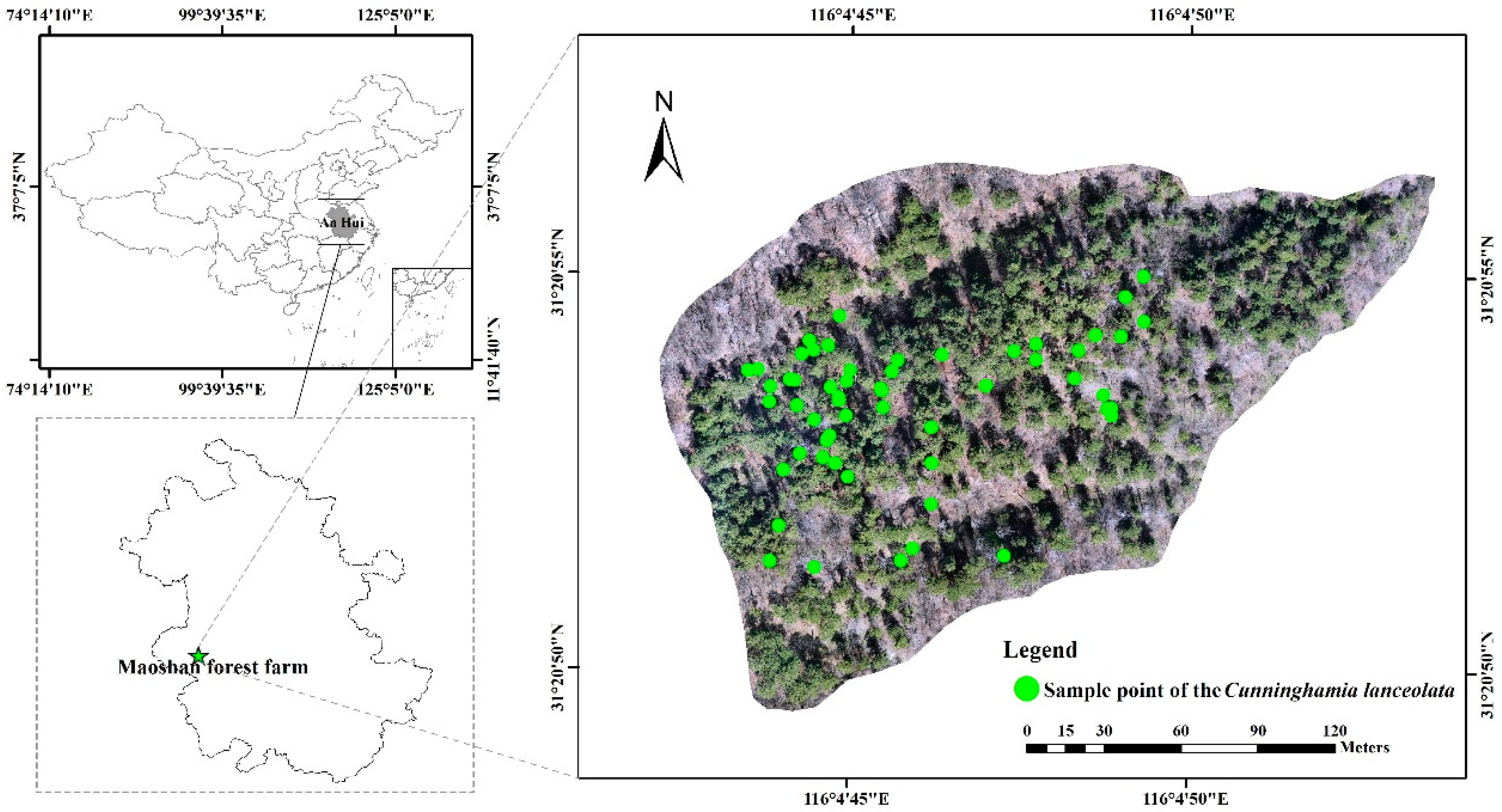
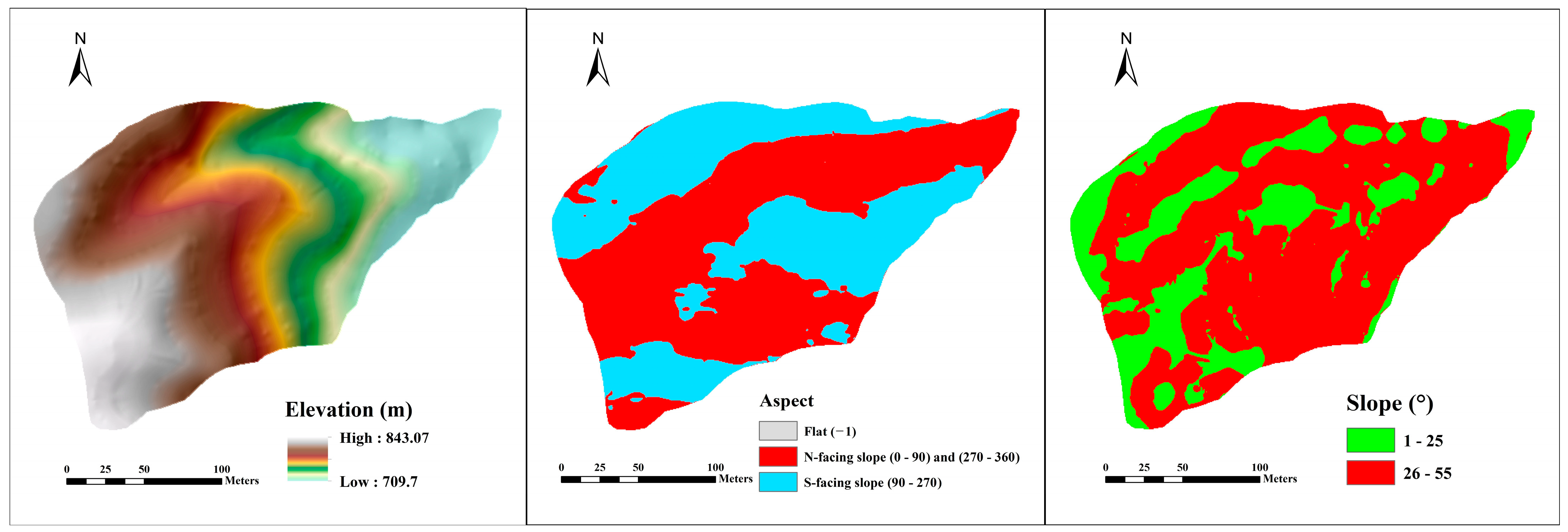
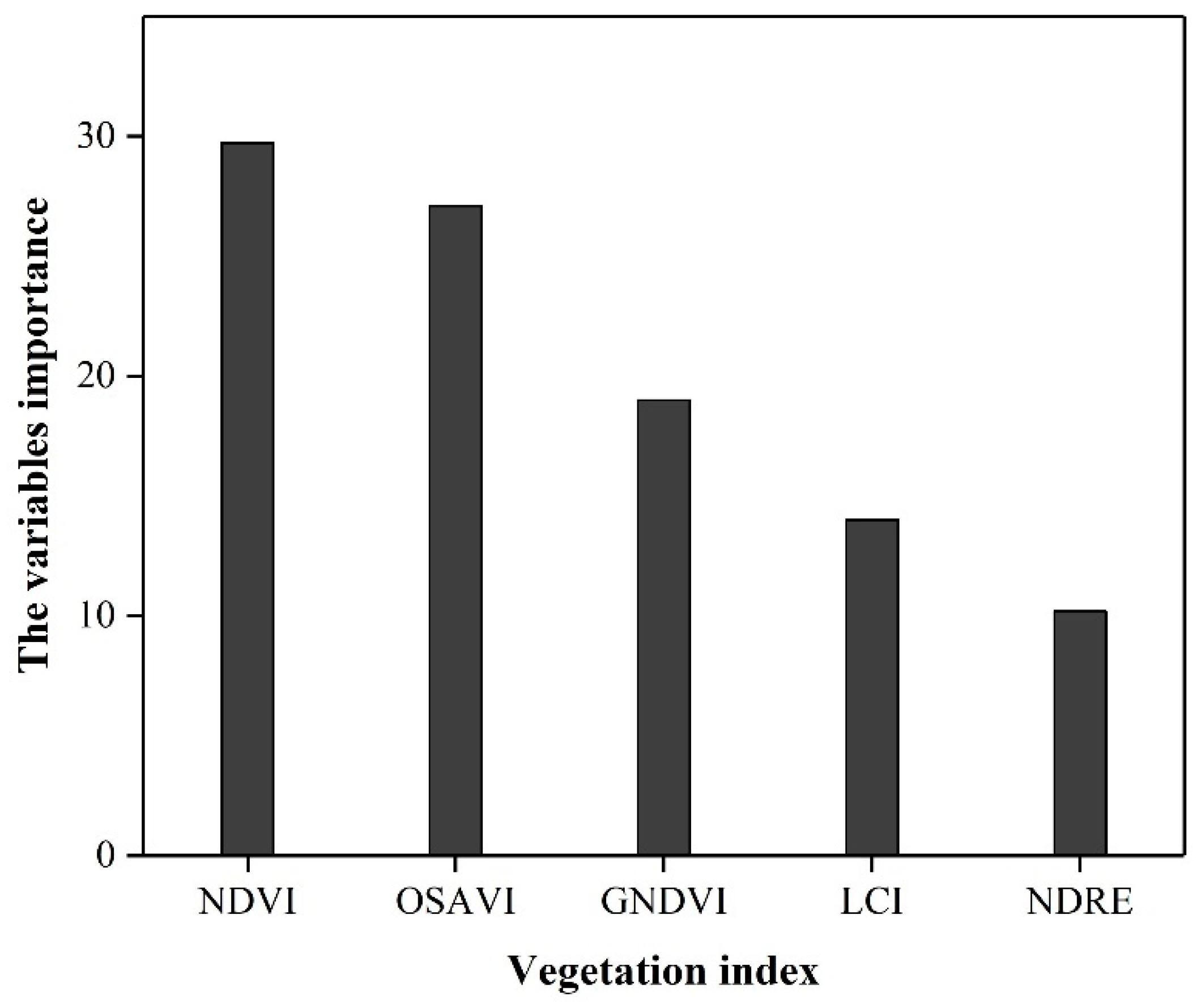
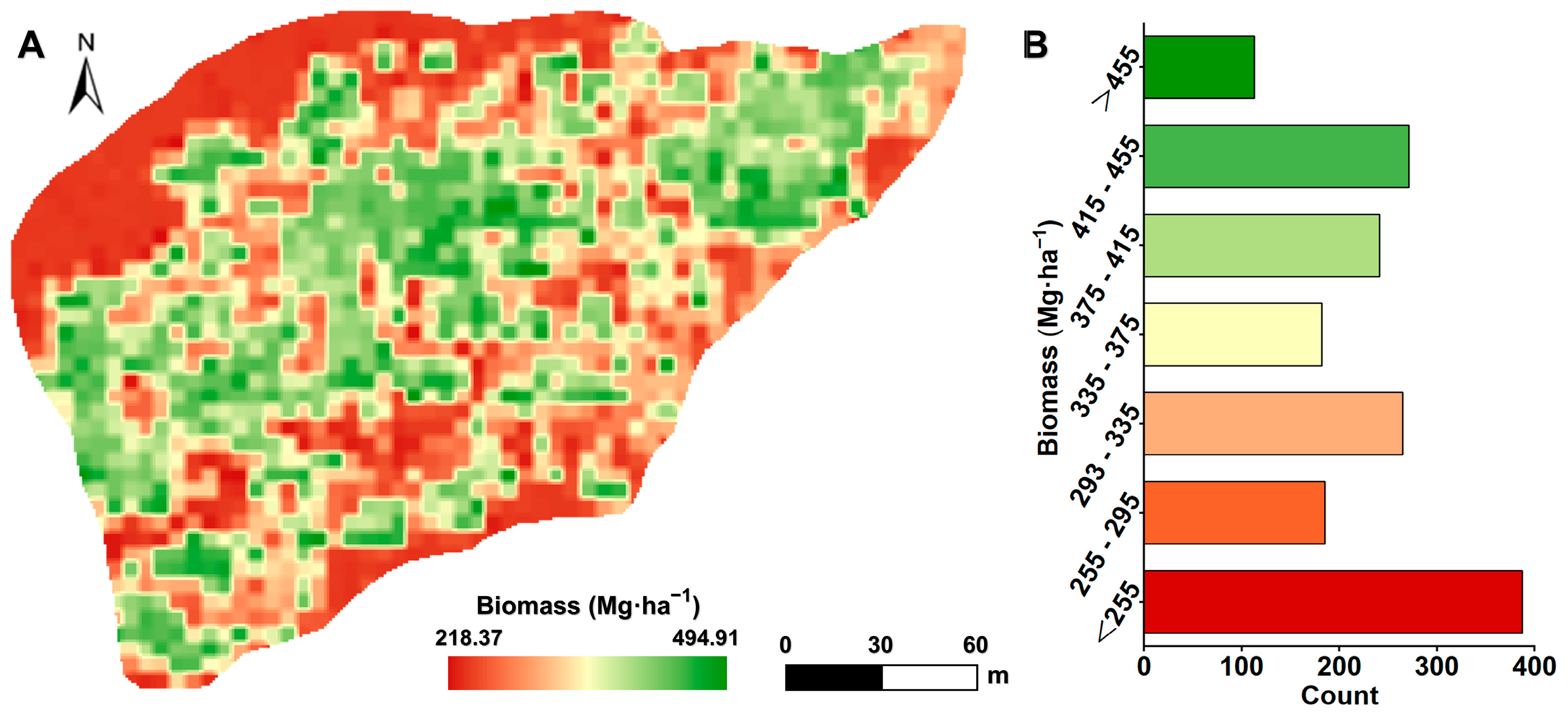

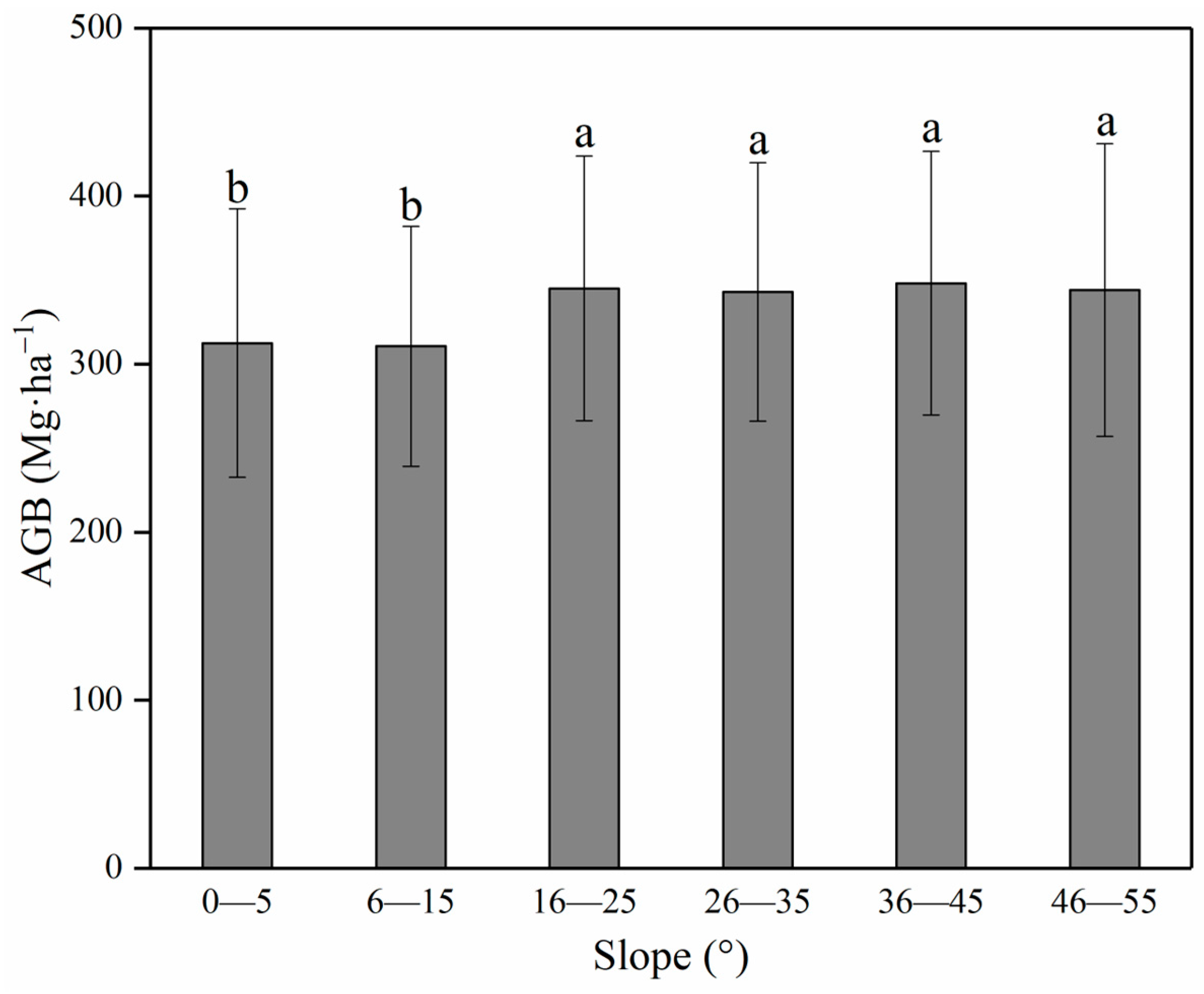


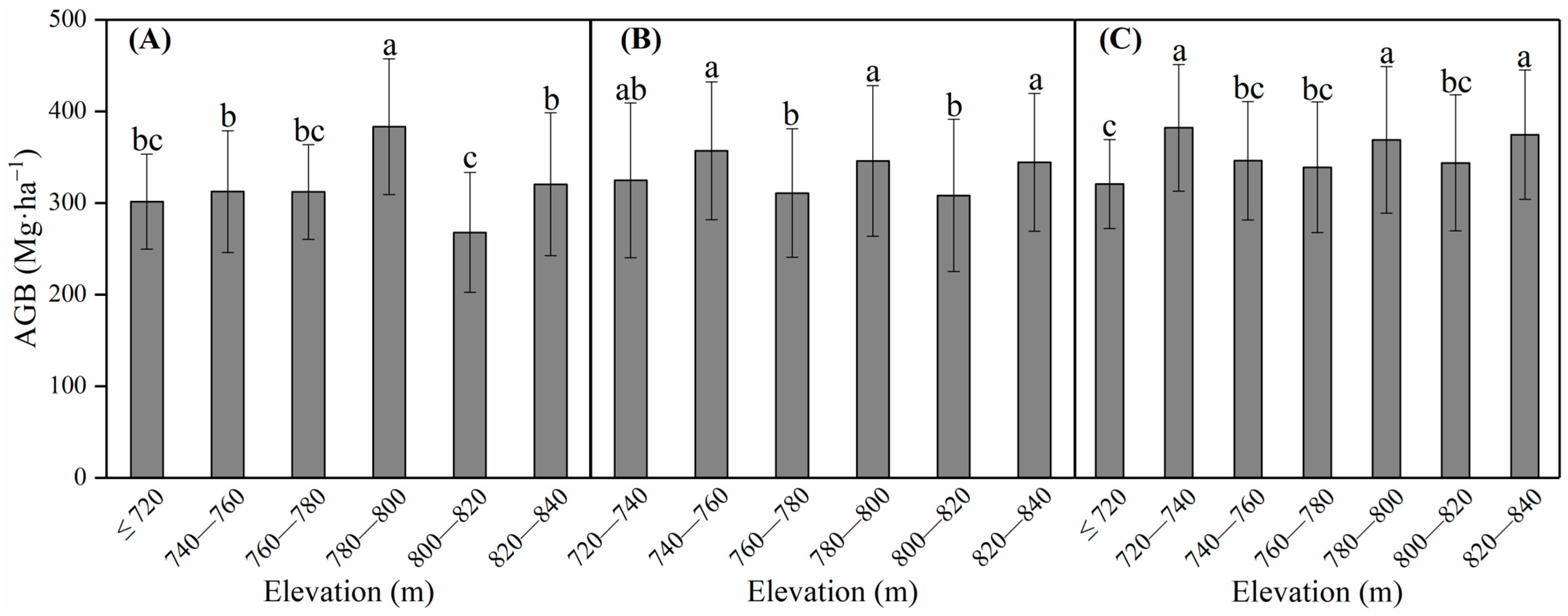
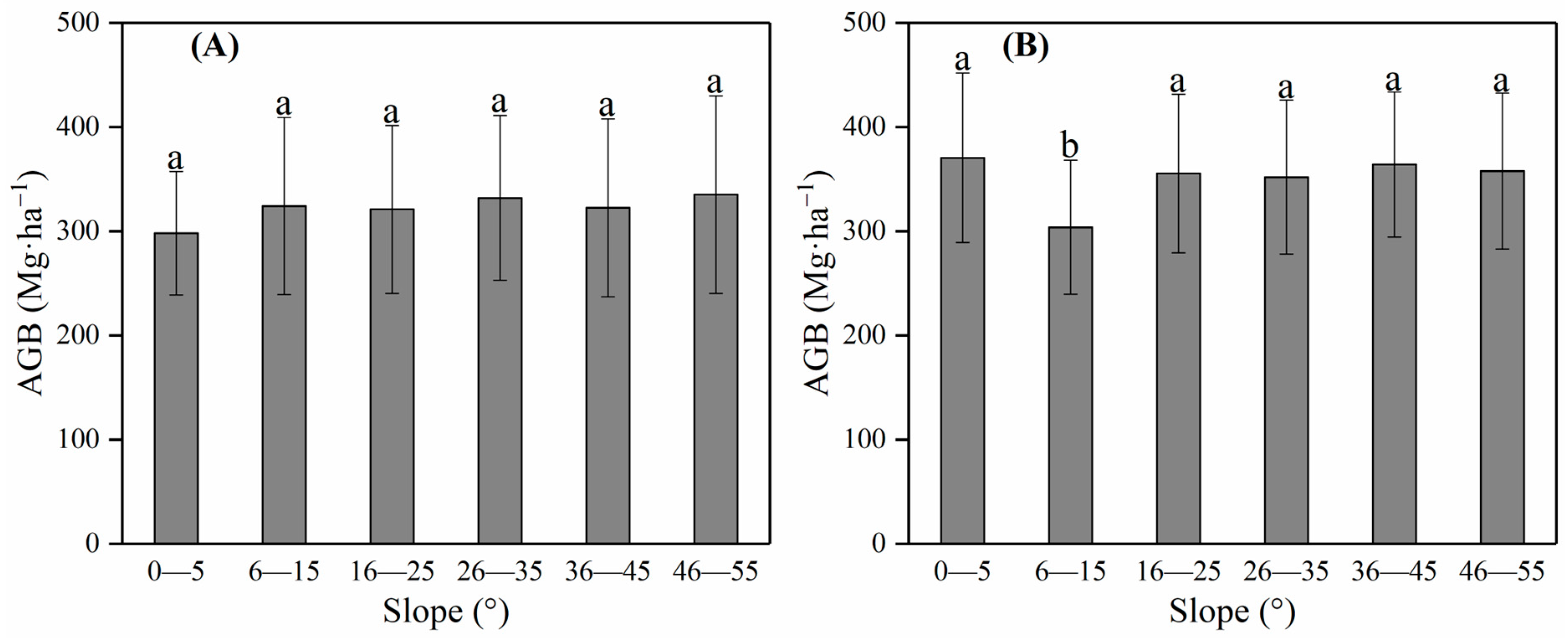
| Vegetation Index | Full Name | Formula |
|---|---|---|
| NDVI | Normalized Difference Vegetation Index | (Nir − Red)/(Nir + Red) |
| GNDVI | Green Normalized Difference Vegetation Index | (Nir − Green)/(Nir + Green) |
| NDRE | Normalized Difference Red Edge | (Nir − RedEdge)/(Nir + RedEdge) |
| LCI | Leaf Chlorophyll Index | (Nir − RedEdge)/(Nir + Red) |
| OSAVI | Optimized Soil Adjusted Vegetation Index | (Nir − Red)/(Nir + Red + 0.16) |
| Individual Tree AGB | Sample Size | Minimum Value | Maximum Value | Mean Value | Standard Deviation | Coefficient of Variation |
|---|---|---|---|---|---|---|
| Measured | 55 | 180.36 | 614.14 | 374.89 | 85.72 | 22.87% |
| Estimated | 1644 | 218.37 | 494.91 | 339.34 | 78.75 | 23.21% |
Disclaimer/Publisher’s Note: The statements, opinions and data contained in all publications are solely those of the individual author(s) and contributor(s) and not of MDPI and/or the editor(s). MDPI and/or the editor(s) disclaim responsibility for any injury to people or property resulting from any ideas, methods, instructions or products referred to in the content. |
© 2024 by the authors. Licensee MDPI, Basel, Switzerland. This article is an open access article distributed under the terms and conditions of the Creative Commons Attribution (CC BY) license (https://creativecommons.org/licenses/by/4.0/).
Share and Cite
Chen, A.; Zhao, P.; Li, Y.; He, H.; Zhang, G.; Li, T.; Liu, Y.; Wen, X. Estimation and Spatial Distribution of Individual Tree Aboveground Biomass in a Chinese Fir Plantation in the Dabieshan Mountains of Western Anhui, China. Forests 2024, 15, 1743. https://doi.org/10.3390/f15101743
Chen A, Zhao P, Li Y, He H, Zhang G, Li T, Liu Y, Wen X. Estimation and Spatial Distribution of Individual Tree Aboveground Biomass in a Chinese Fir Plantation in the Dabieshan Mountains of Western Anhui, China. Forests. 2024; 15(10):1743. https://doi.org/10.3390/f15101743
Chicago/Turabian StyleChen, Aimin, Peng Zhao, Yuanping Li, Huaidong He, Guangsheng Zhang, Taotao Li, Yongjun Liu, and Xiaoqin Wen. 2024. "Estimation and Spatial Distribution of Individual Tree Aboveground Biomass in a Chinese Fir Plantation in the Dabieshan Mountains of Western Anhui, China" Forests 15, no. 10: 1743. https://doi.org/10.3390/f15101743






